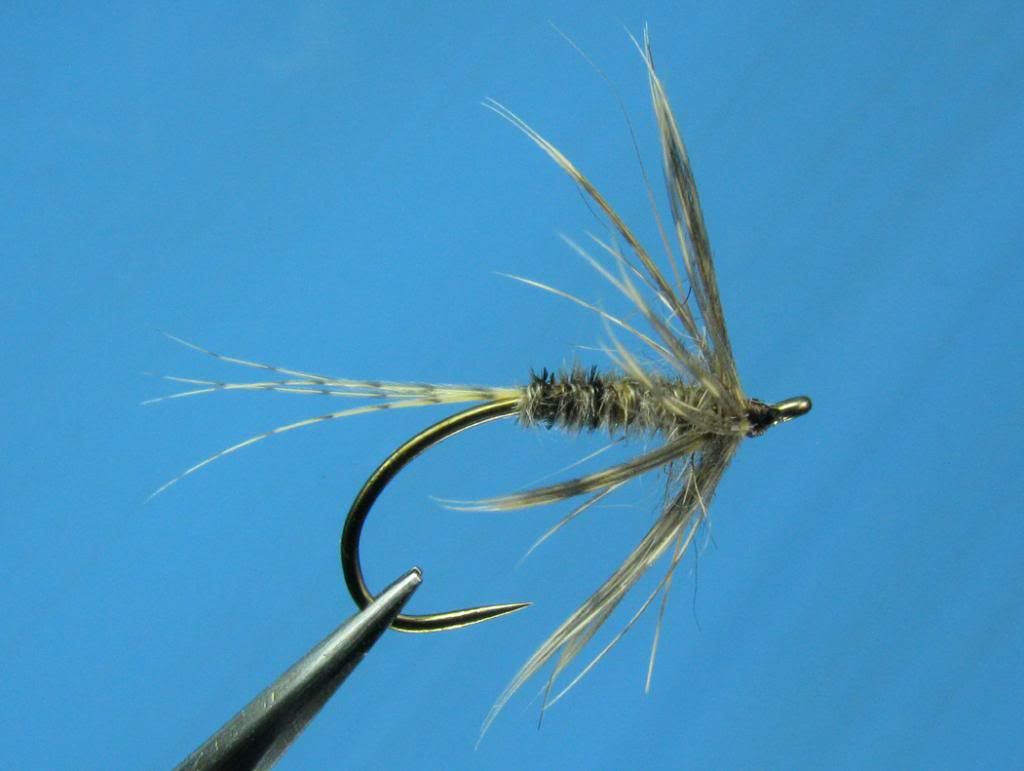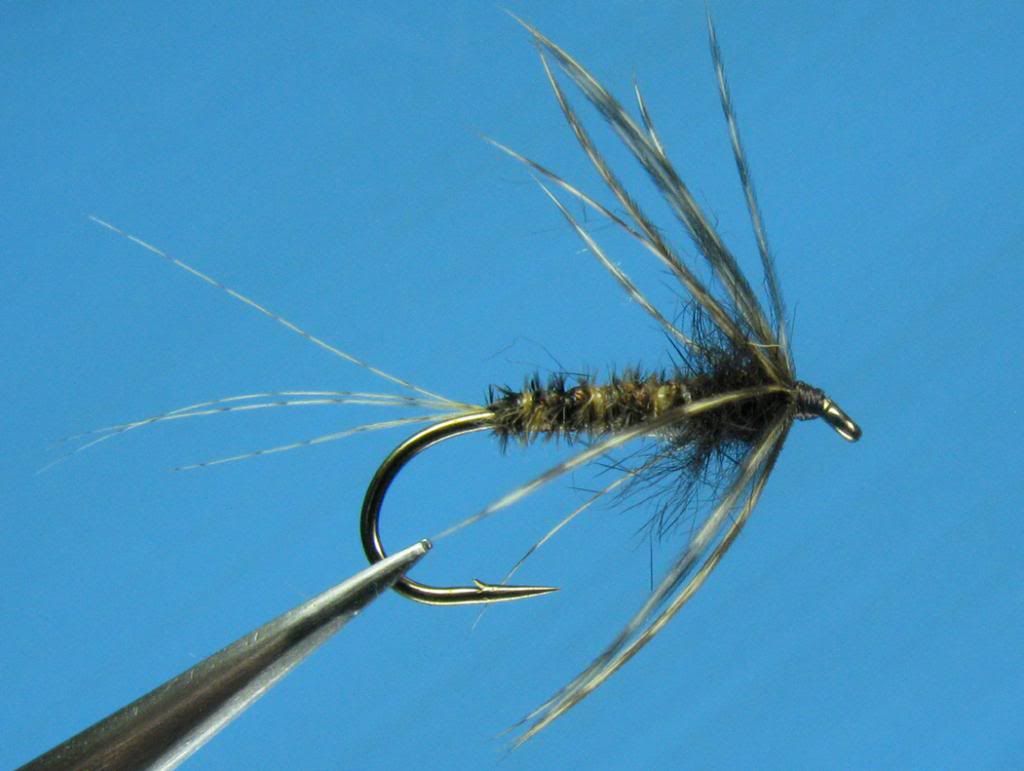Page 1 of 2
PMD Nymph Soft Hackles
Posted: Tue Mar 05, 2013 10:01 am
by William Anderson
So the attempt - working it out - series of active PMD nymphs.
PMD Nymph Goose Turkey Hen 1180
Hook: Daiichi 1180 (dry fly hook)
Thread: Griffiths 14/0 Brown
Hackle: Unique brown Indian hen cape
Tail: Woodduck barbs
Abdomen: Wild Canadian Goose breast flat twisted with dyed Yellow Turkey flat and brown silk
Thorax: Dark Brown Mole
 PMD Nymph Golden Pheasant Goose Speckled Hen 1250
PMD Nymph Golden Pheasant Goose Speckled Hen 1250
Hook: Daiichi 1250
Thread: Griffiths 14/0 Brown
Hackle: Speckled Hen Cape
Tail: Woodduck barbs
Abdomen: Golden Pheasant tail herl and wild Canadian Goose breast flat twisted with brown silk
Thorax: Hares mask and pine squirrel blend
 PMD Nymph Golden Pheasant Turkey and Brahma 1180
PMD Nymph Golden Pheasant Turkey and Brahma 1180
Hook: Daiichi 1180 (dry fly hook)
Thread: Griffiths 14/0 Brown
Hackle: Brahma Hen Cape
Tail: Woodduck barbs
Abdomen: Golden Pheasant tail herl and dyed yellow turkey flat twisted with brown silk
Thorax: Dark Brown Mole
 PMD Nymph Golden Pheasant and Partridge 1180
PMD Nymph Golden Pheasant and Partridge 1180
Hook: Daiichi 1180 (dry fly hook)
Thread: Griffiths 14/0 Brown
Hackle: Partridge
Tail: Woodduck barbs
Abdomen: Golden Pheasant tail herl twisted with orange silk
Thorax: Muskrat, Beaver, Mole and Hare Mask blend

Somewhere here there is a combination that will work.

w
Re: PMD Nymph Soft Hackles
Posted: Tue Mar 05, 2013 10:11 am
by tie2fish
As per usual, all your versions look really good to me, w. Based on what I've seen looking at images of PMD nymphs, they seem to have a pronounced taper to them, and sport varigated legs in most cases. For these reasons only, I prefer your last (4th) pattern.
Re: PMD Nymph Soft Hackles
Posted: Tue Mar 05, 2013 11:31 am
by Old Hat
I like the variegated body on the 4th and the proportions.
All of them are great examples and I don't think the fish would turn either of them away or really be able to distinguish between them for that matter. My only suggestion, and it is just a preference, is that I like proportionally shorter hackle on nymph patterns than say, emerging duns. You aren't trying to mimic a wing, but legs and a darkened swollen thorax pre-emergence.
Re: PMD Nymph Soft Hackles
Posted: Tue Mar 05, 2013 1:06 pm
by letumgo
William - These are fantastic. My goodness, all of them would give me great confidence at the end of my line. Wow (and then some)!
Re: PMD Nymph Soft Hackles
Posted: Tue Mar 05, 2013 7:03 pm
by Kelly L.
Number 2 is my favorite. Great job on all of them.
Re: PMD Nymph Soft Hackles
Posted: Fri Mar 08, 2013 3:55 am
by Ruard
I like the first and the last one. Is the PMD also a fly for the Catskills??
greeting
Re: PMD Nymph Soft Hackles
Posted: Fri Mar 08, 2013 7:15 am
by redietz
Ruard wrote:I like the first and the last one. Is the PMD also a fly for the Catskills??
greeting
The short answer is yes, but it's called a sulfur. I use exactly the same flies for PMD's in the west as for the little sulfur in the east.
The more complicated answer is that the PMD (the insect, not the pattern) has been recently reclassified as
Emphemerella dorothea infrequens, making it the same species (but a different subspecies) as the little sulfur (i]Emphemerella dorothea dorothea[/i]. The only real difference to the angler is that PMD's tend to hatch earlier in the day (but not always) and are a bit less yellow in the dun.
The rendezvous in Roscoe is probably going to be a bit early for the little sulfur, although if we have another year like last year, we may see some.
Re: PMD Nymph Soft Hackles
Posted: Fri Mar 08, 2013 8:09 am
by DUBBN
They can be extremely bright Yellow here in the West. It depends on what river system/drainage. They can also be very dull in color. Just depends.
Re: PMD Nymph Soft Hackles
Posted: Fri Mar 08, 2013 8:55 am
by redietz
DUBBN wrote:They can be extremely bright Yellow here in the West. It depends on what river system/drainage. They can also be very dull in color. Just depends.
Yeah, and it also depend on how late in the hatch, etc.
Re: PMD Nymph Soft Hackles
Posted: Fri Mar 08, 2013 9:26 am
by William Anderson
Thanks so much for the kind comments and feedback.
I would agree with an entomologically logical pattern which uses short hackle, or no hackle at all, to suggest nymphs and believe that's probably the best representation. I also hold these truths to be self-evident, that neither long-hackle or short-hackle patterns should be put aside, one for the other.

The longer hackles on some flymphs and spider patterns create an action and life-like suggestion of life which can imitate the action of a nymph. Both prospects equally true and probably best to tie the short hackle nymph pattern as a trailer to the long hackle nymph pattern.

Regarding the colors, values, etc. of the nymphs and duns. I am embracing the variations from region to region. I don't usually get to hung up on shades of color as much as values. But it's fun to work it out in a specific way. Ruard, Bob is on the money regarding the sulphurs in Roscoe. We probably won't run into any...but we did last year, and they were just the thing. Can't hurt.
w








